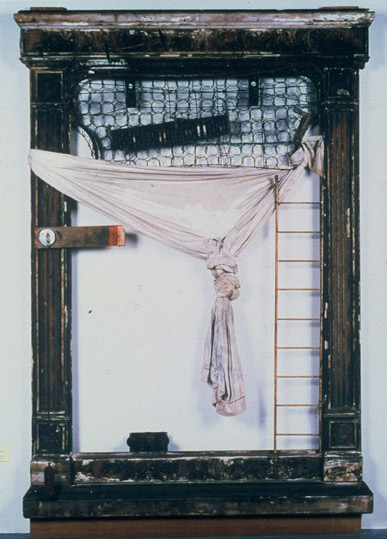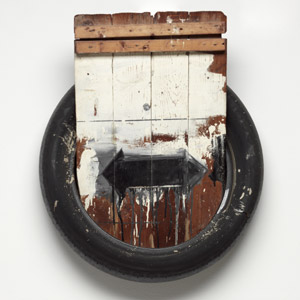
Robert Rauschenberg Trophy III (for Jean Tinguely), 1961
Combine: oil and print on carved wooden structure with metal bed springs, metal ladder,
cloth, fuse box with fuses, metal dish, eyehook, nails 243.8 x 167 x 26.7 cm
The Museum of Contemporary Art, Los Angeles. The Panza Collection
© 2009, Estate of Robert Rauschenberg / licensed by VAGA, New York
ProLitteris, 8033 Zürich Photo: The Museum of Contemporary Art, Los Angeles
|
|
MUSEUM TINGUELY
Paul Sacher-Anlage 1
4002 BASEL
INFORMATION:
Tel: +41 (0)61 681 93 20
Fax: +41 (0)61 681 93 21
E-mail: infos@tinguely.ch
Website : www.tinguely.ch
OPENING HOURS:
Tuesday to Sunday: 11am-7pm.
Closed Monday
December 24, 11am–4pm
December 26, 11am–5pm
December 31, 11am–4pm
Closed on January 1, December 25
ENTRANCE FEES:
Adults: CHF 15.
Students, trainees, seniors: CHF 10.
Free under 16.
CURATORSHIP:
Roland WETZEL and Annja MÜLLER-ALSBACH
PRESS CONTACT:
Laurentia Leon
Tel: +41 (0)61 687 46 08
E-mail: laurentia.leon@roche.com

|
The show sheds light on a chapter in the history of art that was exemplary for the intense artistic exchanges of the period, the fecund rapport between artistic disciplines and the rapprochement of art and life, central issues in equal measure for both Tinguely and Rauschenberg. The aim to revolutionise traditional art by combining genres and an interactive art-environment is what binds both artists, in particular in the 1960s. Inspired and fired by models of the Dada generation – first and foremost by Marcel Duchamp – Rauschenberg and Tinguely were intensely occupied with the possibilities of integrating various forms of technique. They sought for possibilities to incorporate kinetics, light, sound as well as the time factor in their art.
Towards a global artwork
Both artists were aware that working in cooperation advanced their search for a global artwork. This philosophy and their common interest in combining art with technology led to a first collaboration in New York in 1960 on the occasion of Jean Tinguely’s Homage to New York, the sensational action in the garden of the Museum of Modern Art in which an artistic contraption self-destructed into separate parts. Robert Rauschenberg’s contribution to the project was Money Thrower for Tinguely’s H.T.N.Y, a centrifugal money catapult. A friendship grew between both artists, its importance manifested in Robert Rauschenberg’s Combine entitled Trophy III (for Jean Tinguely) in 1961. It is one of only five works that Rauschenberg dedicated to fellow artists, the others – apart from Tinguely – being Merce Cunningham, Teeny and Marcel Duchamp, John Cage and Jasper Johns.
Stage performances
Their artistic collaboration is reflected in outstanding exhibition projects of the 1960s like the comprehensive travelling exhibition partly curated by Pontus Hultén that opened in Amsterdam under the title “Bewogen Beweging“ as well as the project ”Dylaby” (August 30 to September 30, 1962), also held at the Stedeljik Museum in Amsterdam. For the Amsterdam venue of “Bewogen Beweging“, Rauschenberg created Black Market, and in Stockholm he presented the two Combines Door and Johanson’s Painting. Tinguely on the other hand, who was the most extensively represented artist with 27 works, caused a stir in Amsterdam, especially with his Ballet des pauvres, and in Stockholm, with his Narva that was installed on the square in front of the Museum. The outcome of both artists’ interest for the visualisation of time and movement and the presence of the onlooker were their joint stage performances: Variation II (also Homage to David Tudor) on June 20, 1961 at the Théâtre de l'Ambassade des États-Unis in Paris as well as Construction of Boston that was performed on May 4, 1962 at the Maidman Playhouse New York. There do remain material traces of these ephemeral performances, especially Rauchenberg’s First Time Painting executed during the exhibition in Paris.
Following different paths
The cooperative projects led to impressive stages in the artistic evolution of both artists. Shortly after Tinguely’s ephemeral action consisting of movement, smoke, stench and noise in Homage to New York, Robert Rauschenberg requested Billy Klüver’s assistance at the end of March towards the realization of Oracle (1962-65). Initially, Rauschenberg had planned an interactive environment within which a human being in motion could influence the temperature, noise, smell, light, etc. Of further significance for Rauschenberg’s output is, that after his participation in “Dylaby”, to which he contributed a monumental installation in several parts consisting of found objects, he ceases to work on sculptures in order to revert to painting. For Tinguely, on the other hand, after his Homage to New York, began an intense period of artistic creation with a series of ephemeral actions such as the theatrical staging of his “Ends of the World”, End of the World No. 1 and End of the World No. 2
Illustration: Robert Rauschenberg Dylaby (Labyrinth), 1962 Combine: wooden plank, steel nails and rubber wheel 62 x 55 x 31 cm
Kaldor Family Collection © 2009, Estate of Robert Rauschenberg / licensed by VAGA, New York, NY / ProLitteris, 8033 Zürich Photo: Jenni Carter, Art Gallery of New South Wales
PUBLICATION:
A richly illustrated catalogue appears in a German and English edition with essays by Roland Wetzel, Annja Müller-Alsbach, Heinz Stahlhut, Mari Dumett and Jean-Paul Ameline. Basel/Bielefeld 2009, 256 pp., CHF 58.-
To see more illustrations, click on VERSION FRANCAISE at the top of this page
|









